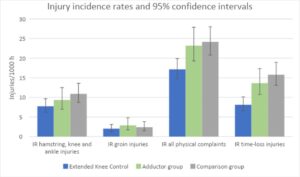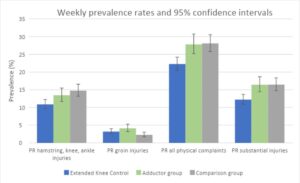Why is this study important?
Injury prevention exercise programmes (IPEPs) efficaciously prevent injuries, but studies show challenges related to low adherence with IPEPs [1-3]. Irrespective of the IPEPs’ efficacy in preventing injuries, the programmes also need to be feasible in a real-world context outside the well-organised randomised controlled trial to be able to prevent injuries effectively.
The main intervention in this randomised trial was extended Knee Control which was a further developed version of the original Knee Control programme from 2005. Knee Control has previously shown efficacy in preventing injuries in youth female football [4], youth male and female floorball [5], and youth male and female handball [6]. Earlier studies on Knee Control showed that coaches often modify programme content and/or dosage to work around barriers for programme use [1-2]. To improve programme feasibility and adherence, in extended Knee Control we added five extra exercise variations/progressions for each of the six main exercises in Knee Control to fit young as well as senior players. We also tried to make recommendations for programme use easier and more flexible.
How did the study go about this?
We conducted a study in one regional football district in Sweden in 2020, where teams were randomised to use extended Knee Control or an adductor strength programme. Teams who already used an IPEP on a regular basis took part in a non-randomised comparison group. In total, 502 male and female players (mean age 20.0±5.7 years) were included. Players responded to weekly questionnaires about occurrence of injury based on the Oslo Sports Trauma Research Center questionnaire, and their exposure to training and matches.
Teams using extended Knee Control were recommended to use the programme on every training session for 15-20 minutes, 30-60 seconds per exercise and two sets. The adductor strength programme exercises and dosage were initially identical to the Adductor Strengthening Programme that has shown positive effects on groin injury rates in male sub-elite players [7]. However, due to the COVID-19 pandemic we added two extra single-player exercises to avoid close contact, adductor squeeze with bent and with straight legs [8].
What did the study find?
We found 29% lower incidence of injuries to the hamstring, knee and ankle in extended Knee Control compared to the comparison group (Figure 1). To prevent one injury in the hamstring, knee or ankle, seven players would have to perform extended Knee Control during one season. We also saw 42-48% lower incidence of time-loss injuries in extended Knee Control compared to the other two groups.
Figure 1. Injury incidence rates (IR) and 95% confidence intervals

We found 17-26% lower hamstring, knee and ankle injury prevalence rates in extended Knee Control compared to the adductor and comparison group respectively (Figure 2). Prevalence of substantial injuries was 27 and 25% lower in extended Knee Control compared to the adductor and comparison group respectively. No preventive effect was seen on groin injury rates from the adductor programme.
Figure 2. Weekly injury prevalence rates (PR) and 95% confidence intervals
What are the key take-home points
The extended Knee Control group had a lower rate of injuries to the hamstring, knee and ankle combined, time-loss and substantial injuries as compared to the adductor and comparison group. The results are particularly interesting considering that the comparison group may already have had a relatively speaking low injury risk from having used preventive exercises on a regular basis at least the previous season. No effect was seen from the adductor programme but this group was smaller than the other groups and particularly included few male players, rendering low power.
References
- Lindblom H, Waldén M, Carlfjord S, et al. Implementation of a neuromuscular training programme in female adolescent football: 3-year follow-up study after a randomised controlled trial. Br J Sports Med 2014;48:1425-30.
- Lindblom H, Carlfjord S, Hägglund M. Adoption and use of an injury prevention exercise program in female football: A qualitative study among coaches. Scand J Med Sci Sports 2018;28:1295-1303.
- O’Brien J, Young W, Finch CF. The delivery of injury prevention exercise programmes in professional youth soccer: Comparison to the FIFA 11+. J Sci Med Sport 2017;20:26-31.
- Waldén M, Atroshi I, Magnusson H, et al. Prevention of acute knee injuries in adolescent female football players: cluster randomised controlled trial. BMJ 2012;344:e3042.
- Åkerlund I, Waldén M, Sonesson S, et al. Forty-five percent lower acute injury incidence but no effect on overuse injury prevalence in youth floorball players (aged 12-17 years) who used an injury prevention exercise programme: two-armed parallel-group cluster randomised controlled trial. Br J Sports Med 2020:54;1028-35.
- Asker M, Hägglund M, Waldén M, et al. The effect of shoulder and knee exercise programmes on the risk of shoulder and knee injuries in adolescent elite handball players: A three-armed cluster randomised controlled trial. Sports Med Open 2022;8:91.
- Harøy J, Clarsen B, Wiger EG, et al. The Adductor Strengthening Programme prevents groin problems among male football players: a cluster-randomised controlled trial. Br J Sports Med 2019;53:150-7.
- Hölmich P, Larsen K, Krogsgaard K, et al. Exercise program for prevention of groin pain in football players: a cluster-randomized trial. Scand J Med Sci Sports 2010;20:814-21.
Authors and affiliations
Hanna Lindblom(1, 2), Sofi Sonesson(1,2), Kalle Torvaldsson(1,2), Markus Waldén(2,3), Martin Hägglund(1,2)
1. Department of Health, Medicine and Caring Sciences, Unit of Physiotherapy, Linköping University, Linköping, Sweden
2. Sport Without Injury ProgrammE (SWIPE) Department of Health, Medicine and Caring Sciences, Linköping University, Linköping, Sweden
3. GHP Ortho & Spine Center Skåne, Malmö, Sweden
